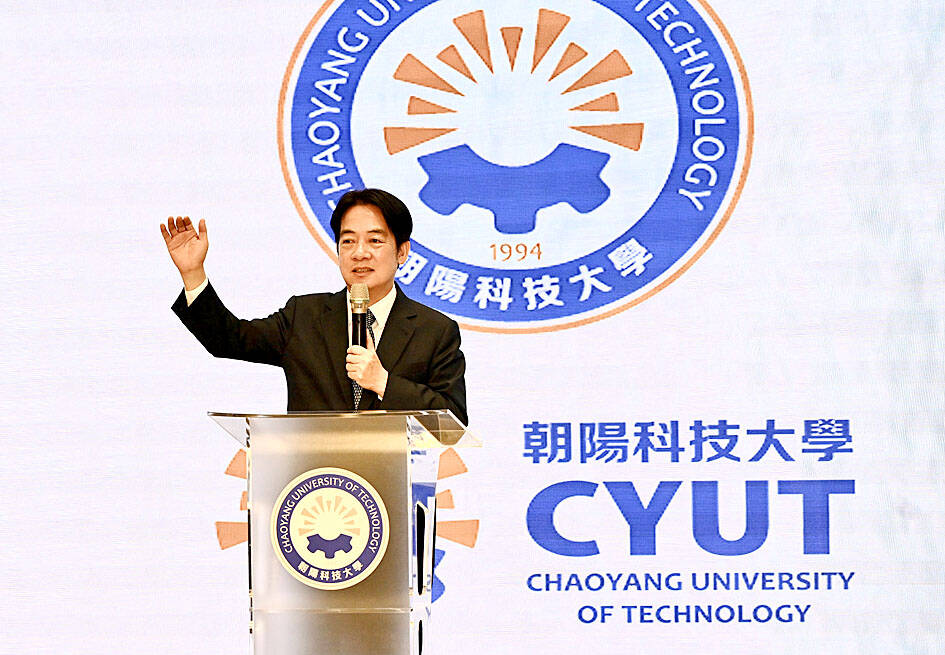The government is to subsidize students at private universities “at least half” of the gap between the tuition fees of public and private universities, which is estimated to be about NT$25,000 (US$809) per year, Vice President William Lai (賴清德) said yesterday.
Lai made the remarks when attending a flag-awarding ceremony at Chaoyang University of Technology’s summer volunteers camp in Taichung.
The average tuition fee at public universities is about NT$62,000 per year, while that of private universities is about NT$110,000 per year, which is a gap of about NT$50,000 per year, Ministry of Education Department of Higher Education Director-General Chu Chun-chang (朱俊彰) said.

Photo: Liao Yao-tung, Taipei Times
Although most economically disadvantaged students can receive financial aid for tuition fees, many still need to depend on student loans or part-time jobs to pay for daily expenses, which could affect their education, Chu said, adding that even if they study at public universities, some might still have a financial burden from their daily expenses.
The ministry would subsidize students at private universities by directly deducting the money from the total tuition fee when they pay for it at the beginning of each semester, substantially reducing their financial burden, he said.
The subsidies are to be implemented from the second semester of the 2023-2024 academic year, and approximately 473,000 students at private universities are expected to benefit from it, he added.
Adding existing tuition and miscellaneous fee exemptions and scholarships provided by various government agencies, a total of about 591,000 students at private universities would be eligible for a minimum of NT$25,000 deducted from their tuition and miscellaneous fees, Chu said.
Deputy Minister of Education Lio Mon-chi (劉孟奇) said the subsidy plan is an education policy, not an election campaign promise, and that it is expected to cost about NT$15 billion per year.
Executive Yuan spokesman Lin Tze-luen (林子倫) said the Cabinet supports and approved the policy of closing the gap between the tuition fees of public and private universities.
The Taiwan Youth Association for Democracy yesterday said the gap between tuition fees has often been discussed by students, so the association also agrees with the idea of a subsidy, as it would help ease the financial burden on university students.
The Union of Private School Educators yesterday also issued a statement to express its approval of the policy.
Union president Yu Jung-hui (尤榮輝) said the policy would serve as a morale booster to critically endangered private universities, and although it would not necessarily prevent them from being shut down, it would improve the universities’ competitiveness in recruiting new students and also provide fairer education opportunities for students from economically disadvantaged families.
However, the union said it hopes the policy is only the beginning of reforms, as there are many regulations that need to be amended.
The government should implement a forward-looking blueprint for the future of higher education at private schools, allowing them to become top universities, it said.
Additional reporting by Chen Chien-chih

The Central Weather Administration (CWA) yesterday said it expected to issue a sea warning for Typhoon Fung-Wong tomorrow, which it said would possibly make landfall near central Taiwan. As of 2am yesterday, Fung-Wong was about 1,760km southeast of Oluanpi (鵝鑾鼻), Taiwan’s southernmost point, moving west-northwest at 26kph. It is forecast to reach Luzon in the northern Philippines by tomorrow, the CWA said. After entering the South China Sea, Typhoon Fung-Wong is likely to turn northward toward Taiwan, CWA forecaster Chang Chun-yao (張峻堯) said, adding that it would likely make landfall near central Taiwan. The CWA expects to issue a land

Taiwan’s exports soared to an all-time high of US$61.8 billion last month, surging 49.7 percent from a year earlier, as the global frenzy for artificial intelligence (AI) applications and new consumer electronics powered shipments of high-tech goods, the Ministry of Finance said yesterday. It was the first time exports had exceeded the US$60 billion mark, fueled by the global boom in AI development that has significantly boosted Taiwanese companies across the international supply chain, Department of Statistics Director-General Beatrice Tsai (蔡美娜) told a media briefing. “There is a consensus among major AI players that the upcycle is still in its early stage,”

The Central Weather Administration (CWA) yesterday said it is expected to issue a sea warning for Typhoon Fung-wong this afternoon and a land warning tomorrow. As of 1pm, the storm was about 1,070km southeast of Oluanpi (鵝鑾鼻), Taiwan’s southernmost point, and was moving west-northwest at 28 to 32kph, according to CWA data. The storm had a radius of 250km, with maximum sustained winds of 173kph and gusts reaching 209kph, the CWA added. The storm is forecast to pass near Luzon in the Philippines before entering the South China Sea and potentially turning northward toward Taiwan, the CWA said. CWA forecaster Chang Chun-yao (張峻堯) said

Japanese Prime Minister Sanae Takaichi yesterday said that China using armed force against Taiwan could constitute a "survival-threatening situation" for Japan, allowing the country to mobilize the Japanese armed forces under its security laws. Takaichi made the remarks during a parliamentary session while responding to a question about whether a "Taiwan contingency" involving a Chinese naval blockade would qualify as a "survival-threatening situation" for Japan, according to a report by Japan’s Asahi Shimbun. "If warships are used and other armed actions are involved, I believe this could constitute a survival-threatening situation," Takaichi was quoted as saying in the report. Under Japan’s security legislation,